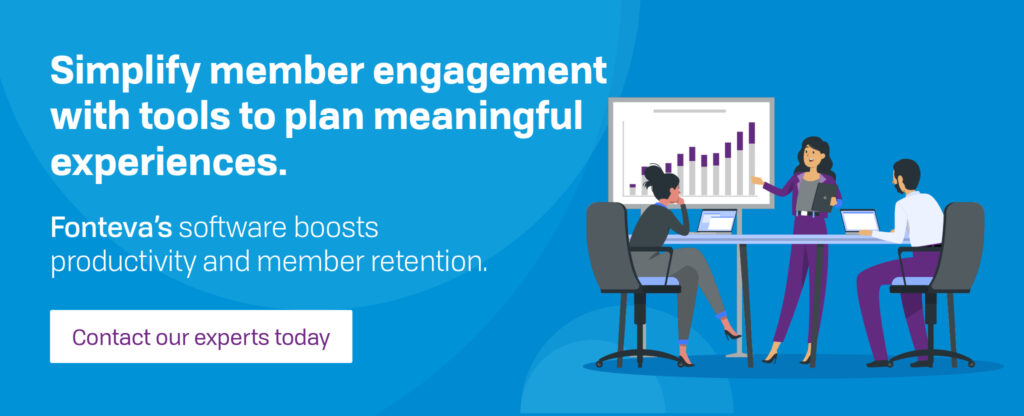Although building an effective member engagement strategy to keep members engaged can feel challenging, it’s not as complicated as it may seem.
In fact, did you know a simple phone call can significantly boost overall and first-year member renewal rates? According to the 2024 Membership Marketing Benchmarking Report, a significant percentage of associations with overall and first-year member renewal rates above 80% make welcome phone calls to new members.
We’ve created this comprehensive guide to help you build a member engagement strategy that exceeds expectations. We’ll review:
- Member Engagement FAQ
- 15+ Effective Member Engagement Ideas
- Member Engagement Ideas for 3 Types of Members
- Execute Your Member Engagement Strategy With Fonteva’s AMS
Don’t wait for your engagement strategies to become obsolete. Use these tips and resources to develop innovative ways to attract new members and encourage renewals.

Member Engagement FAQ
What is member engagement?
Association member engagement is the ongoing member outreach and interactions associations conduct to keep constituents informed, educated, and motivated to continue their memberships. Engaged members tend to be active participants, have meaningful interactions with other members and your team, and perceive value in your membership.
What is a member engagement strategy?
By extension, a member engagement strategy consists of the messaging, content, and opportunities that associations share with their members to encourage interaction. While some members will leap to engage with your offerings as soon as they sign up, others will need more guidance. Poor member engagement rates could be a sign that your offerings as a whole need an upgrade.
Why is member engagement important to association strategy?
Increased member retention
Member engagement is crucial to improving member retention. According to the Membership Marketing Benchmarking Report, “Associations that reported an increase in member engagement in several areas are more likely to report one-year and five-year membership growth and an increase in their renewal rate over the past year.”
In other words, the more you engage your members, the more likely they are to renew their memberships. Remember, retaining existing members is generally more cost-effective than acquiring new ones.
More community-building.
Member engagement doesn’t just help your association develop better relationships with members. It also involves encouraging members to interact and engage with each other.
Foster strong communities that encourage members to connect by:
- Hosting live events. Events give members a chance to come together and socialize, with in-person events allowing for face-to-face interactions.
- Providing an online member portal. A growing membership base requires an intuitive online member portal. Online portals provide access to each member’s individual information, exclusive resources, your community engagement platform, your learning management system, and more. This way, members can communicate with each other in a members-only space and keep in touch continuously throughout the entire year.
- Creating a member directory. Member directories are an essential networking resource that enables members to explore your association’s member base and reach out to one another. Additionally, associations can show off the size and caliber of their directory to promote their organization.
For professional and trade associations, 67% of members cite networking as their top reason for joining. Relationships with others in their industry keep members engaged long-term as they chat online, attend events, and collaborate with or learn from fellow members.
Boost in non-dues revenue
Many associations create revenue sources outside of their regular membership dues to fund their services. Non-dues revenue includes sponsorships, online store sales, and additional paid member engagement opportunities.
Asking members to pay fees in addition to their regular dues can be challenging, but it is possible if these opportunities are valuable, unique, and worthwhile. Be sure your membership program still offers significant benefits so members don’t feel shortchanged if they choose not to pay for add-ons.
For example, event ticket sales are a great way to increase non-dues revenue. Tickets are an extra cost, but events provide a rewarding experience that justifies the purchase.
How can associations measure member engagement?
How you measure engagement depends on the type of membership program you’re running. For example, an alumni association measures member engagement differently from a professional association. The former typically looks at event attendance, while the latter might refer to their learning management system (LMS) to gauge how often members participate in upskilling or continuing education opportunities.
Review the offerings your association already offers and how members interface with them. Then, set your own benchmarks for member engagement by considering your long-term goals (e.g., improving retention, building an online community, or growing your online presence). For instance, observe how your members engage with:
- Online community platforms
- Email marketing
- Live events
- Learning opportunities
- Your social media profiles
Once you understand what member engagement means to your association, quantify these interactions by setting, tracking, and analyzing key performance indicators (KPIs).
Setting KPIs for member engagement
KPIs are strategic metrics your association can set to measure your progress toward specific, quantifiable goals. KPIs help you and your staff measure your association’s performance based on key objectives. After defining what member engagement means to your association, set KPIs to evaluate your success at reaching specific engagement targets.
Here are some examples of KPIs based on where your members may be currently active:
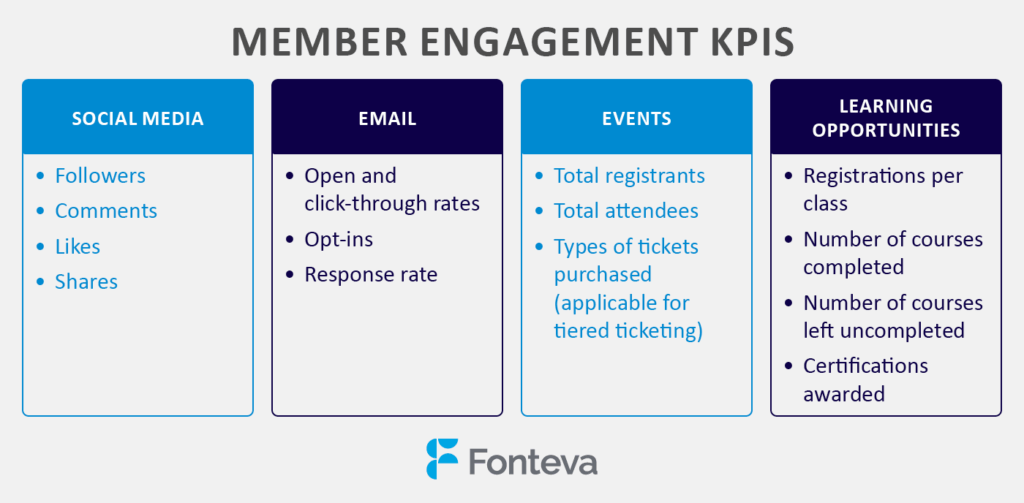
- Social media platforms. Measure your follower count, comments, likes, and profile tags or references on each social media platform you are active on. Pay attention to which posts get the most attention.
- Email marketing. Track your email open and click-through rates, the number of members who opted to receive your newsletter, and the frequency of members’ responses.
- Live events. For each event, record how many people registered, total attendance, how people found out about your event, and the type of tickets people bought.
- Learning opportunities. Track metrics from your association’s LMS system, such as which classes are most popular, how many members received accreditations, and how often members start courses but do not finish.
Specialized tools make tracking member engagement-related KPIs easy. For instance, associations that host their communities on a community engagement platform can generate reports to track the total number of comments, member posts, likes, and so on. These tools can also provide granular data to show how active each member is.
15+ Effective Member Engagement Ideas
1. Gather feedback.
Gathering feedback from members can illuminate the best ways to engage with them and demonstrate that your organization values their insights..
To collect in-depth feedback, consider hosting:
- In-person or virtual meetings, where individual members can meet with your staff and answer a set of questions. Staff will have the opportunity to ask follow-up questions or have members elaborate.
- Focus groups, where a small group of members participates in a guided discussion about a specific topic or concept (e.g., user experience improvements to your member portal).
- Listening tours—a structured set of meetings usually conducted by multi-chapter organizations—give association leaders a chance to hear what members think of their experiences (e.g., an association executive organizes a chapter dinner and has members reflect and answer open-ended questions).

These more in-depth feedback gathering methods aren’t feasible for every event or engagement opportunity. For these occasions, surveys are a more convenient way to collect immediate feedback from members:
- After events. Shortly after events wrap up, follow up with surveys while it’s still fresh in members’ minds.
- When it’s time for membership renewal. Request feedback when members decide whether or not to renew. If members decide to leave your association, ask them why.
- At the end of the year. The end of the year is generally a time for reflection, and associations can use this as an opportunity to ask members to provide feedback on their experiences.
These surveying processes are also an effective way to collect testimonials for marketing purposes. You can identify which members feel very positive about your organization and ask if you can use their stories in your marketing materials.
2. Segment your members by interests.
Not all members will feel engaged by the same activities. Segment your members based on relevant characteristics, such as their:
- Tenure as a member: While new members should be greeted with welcome emails and onboarding materials, veteran members might be looking for opportunities to join your leadership team (more on this later in the guide!).
- Interests: Determine common interests among your members and create corresponding member segments. For instance, an association for healthcare professionals might create segments for different specialties, like cardiology, pediatrics, and oncology.
- Geographic location: Segmenting members by geographic location can be helpful for organizing in-person events, conferences, or networking opportunities. If you’ll be holding a networking happy hour in Atlanta, for instance, you can easily send an invite to members based within 50 miles of the city.
Ultimately, you can create whatever member segments are needed to best engage your community. For example, if helping members get employed or earn promotions is a big part of your mission, segment by employment status. A professional association might divide members into job-seekers and current professionals and offer the following communications:
- Job-seekers: Promotion for skill-training courses, recommendation to sign up for your membership program, suggested network connections, and alerts when new openings are added to your job board
- Current professionals: Promotion for upcoming conferences, invitations to a lecture with multiple industry professionals, recommendations to read articles on new industry developments, and encouragement to share their thoughts through community posts
While these member groups may enjoy activities geared toward specific audiences, segmenting helps guide members toward the content that is most likely to engage them.
3. Use advertising to promote engagement opportunities.
After crafting meaningful member engagement opportunities like members-only events and learning opportunities, you need your members to know about these opportunities. Paid advertising is a fantastic way to amplify member perks and inspire people to engage.
For nonprofits with membership programs, here are a few paid advertising strategies to promote member engagement:
- Google Ads: Use Google Ads to promote your website and encourage members to explore online resources like webinars, educational materials, and discussion forums. You can also promote your events. Best of all, eligible 501(c)(3) organizations can leverage this paid advertising channel for free through the Google Ad Grant program.
- Social media ads: Show up in members’ news feeds by running ads for upcoming events, membership drives, and other initiatives to encourage participation. By using targeting features, you can reach current and potential members alike.
- Retargeted ads: Reconnect with users who have previously engaged with your website or social media content. Whether they abandoned your membership form or an event registration form, you can inspire them to complete specific actions personalized to their interests.
Paid ads can be immensely helpful in engaging current members and inspiring new prospects to sign up. With thoughtful strategies, you can increase visibility for your initiatives, deliver ads to the right audiences, and drive more traffic to your site and social media.
4. Improve your communication strategies.
Members signed up for your association because they want to engage with your content. To get a positive response, you need to communicate with them in a way that fits their preferences.
Improve your communication strategy by:
- Letting members choose their preferred mode of communication. Take a proactive approach by asking members for their preferences. This might be email, text message, or through your online community platform. After members share their preferences, only reach out to them through that channel.
- Leverage data. Explore previous engagement data to determine which channels a particular member responds best to. You may also check what times of day they tend to respond to messages and base your communication strategy on that.
- Personalize messages. Segment your members and tailor each message based on their particular preferences and engagement histories. You can do this by customizing existing templates within your AMS platform to personally address each recipient.
If you’re not sure what types of messages members will respond positively to, take time to experiment. Change up your communication style, the types of messages you send, and what platforms you use. Then, look at the results of your tests and base future outreach strategies on that data.
5. Host engaging events.
One of the most appealing parts of joining an association is the events. In-person meetings help members build connections and form a community around your association.
Most associations host a handful of in-person events throughout the year and several virtual events. It can be challenging to make virtual events engaging, so try making your online meet-ups interactive by:
- Doing live polls. Let members influence your online events by launching polls and surveys that members can respond to during the event. Gauge their opinion or familiarity on a topic, ask questions, prompt them to share ideas, or gather the topics they’d like the event to cover.
- Having active moderators. Your association should always have moderators in your events’ live chat. Direct these moderators to not just screen comments that don’t reflect your values but also to actively engage members by asking questions, highlighting insightful comments, and sparking conversations.
- Creating breakout groups. Ensure members don’t miss out on socialization just because they’re meeting online. Plan breakout group sessions in your virtual events to give members a chance to chat with one another about your event, bounce ideas off one another, or even engage collaboratively.
Ensure your association management software has adequate event hosting software to accommodate virtual events. Promote your event regularly in advance to drive attendance.
6. Make new members feel welcome and existing members feel valued.
Your member engagement strategy should start on day one. As soon as a member joins your association, focus on engaging them. Send a welcome packet containing relevant association information about how to access your association’s benefits, such as login information for your online portal and information on any upcoming events.
However, don’t forget about those who have stayed loyal to you over the years. Tenured members should still feel valued, as their continual contributions and engagement are vital to your association’s longevity. Maintain positive member engagement by continuously communicating your appreciation for their membership.
7. Offer many ways to engage.
Don’t focus on just one method of member engagement. While it’s wise to have a goal for your association to work toward, don’t let other engagement opportunities fall by the wayside.

To get started, here are some digital member engagement opportunities:
- Online member portal. Provide a space for members to connect with others in their community. This should be a social media-like platform where members can post content, comment on each other’s posts, and directly message one another.
- Community message board. Members can actively engage with each other through forums, collaborate on documents, and comment on each other’s ideas.
- Learning management system. With an LMS, you can offer online courses for members to further their education and gain certifications.
Also, remember the value of face-to-face engagements. Consider these in-person member engagement opportunities:
- Events. Host conferences, presentations, and more to engage your members in person. This way, they can interact with each other throughout the event and make face-to-face connections with their fellow members.
- Learning opportunities. Offer in-person classes and learning events for members to further their education.
- Meetings. Oftentimes, your association will have committees and subsections. Encourage them to meet in person on a regular basis so that they can efficiently accomplish objectives.
8. Foster a sense of community.
Make networking easy by taking steps to foster a community. You can help members jumpstart their networking efforts by:
- Creating a mentorship program. New members may be overwhelmed when first joining your association and unsure about how to start networking. Help them overcome this hurdle by asking long-standing members to serve as mentors. Connect new members with these mentors to ensure they have someone they can ask questions to and who will be a friendly face at their first in-person events.
- Hosting an online community. Maintain a vibrant online community to ensure members can connect with each other outside of in-person events. Encourage members to make posts of their own and interact with other members’ content. This can spark conversations in a low-stakes environment that lead to meaningful professional connections.
- Recommending suggested connections. Help members find like-minded individuals by suggesting other members for them to connect with. For example, some associations even help facilitate member meet-ups by asking members to fill out a survey with questions about their interests and professional goals. Then, the association matches them with another member based on their responses and offers to set up a video call or invites them to chat with each other online.
Ultimately, your goal is to get members to engage one another. Your association’s job should be to set up events and create content that invites members to connect with each other and continue those connections long after your planned activities wrap up.
9. Encourage user-generated content.
How do casual online communities continue to operate for years without any formal organization running them? These groups understand the value of user-generated content (UGC) and rely on their members’ own creativity and enthusiasm to spark engagement.
UGC is any type of content made by your members. It can take several forms, such as:
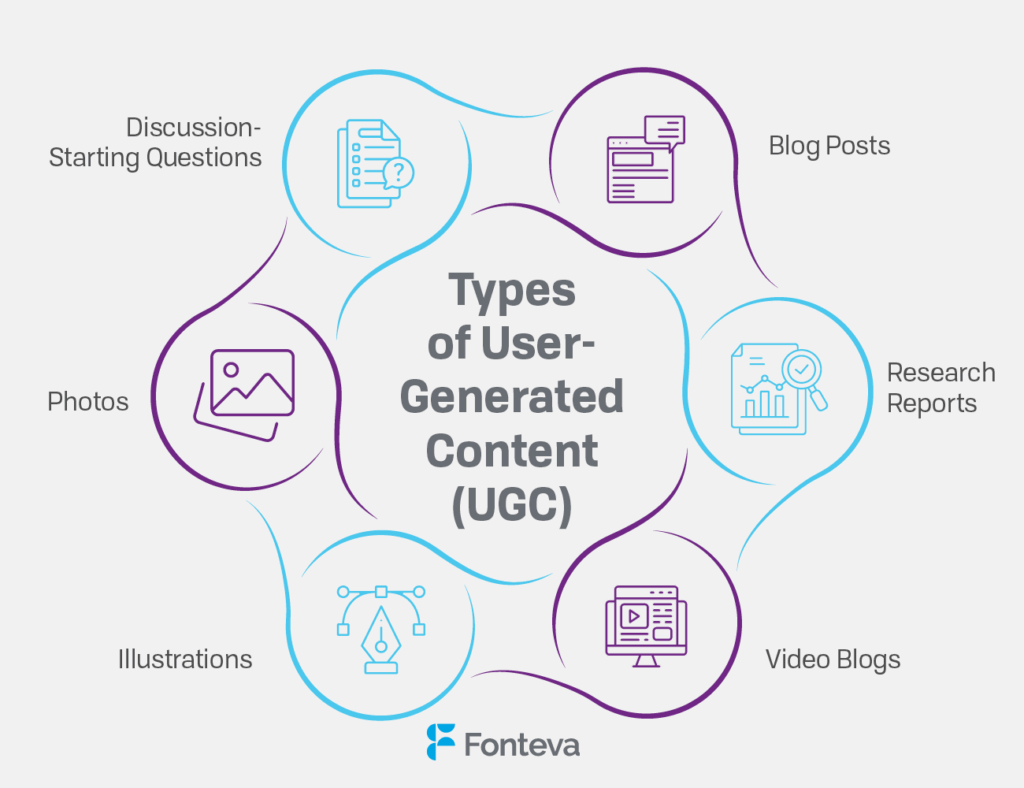
- Discussion-starting questions
- Blog posts
- Research reports
- Video blogs
- Illustrations
- Photos
UGC gives members another active way to participate in your community. Rather than simply consuming content created by your team or industry experts, they can engage deeper with your association and other members by presenting their own thoughts and creations. Your members’ expertise is one of your most valuable resources, and UGC is a great way to tap into it.
10. Gamify engagement.
Gamification is the process of adding game-like elements, including badges, points, and leaderboards, to different aspects of your member engagement strategy. Gamification puts a spin on your association’s activities by turning them into friendly competitions among members, encouraging them to take their involvement to the next level.
Here are a few ideas for ways to incorporate gamification into your member engagement strategy:
- Give members points for participation in meetings and conferences.
- Offer digital badges or achievements members can display on the member directory that are earned through engaging (e.g., a badge they earn by attending 10 in-person events).
- Use your association’s member portal or website to spotlight a leaderboard with your most engaged members.
You could also host fun game-night events for members, like an industry-relevant trivia night. Encourage members to group up in teams to foster social connections.
11. Create interactive social media campaigns.
Social media enables two-way communication between your association and its community. For example, members can comment on your posts or directly message you with their feedback or questions. Then, your association can reply and engage further in a timely manner.
These interactions help members feel more connected to your organization, establish additional communication touchpoints, and prove that you value members’ thoughts and opinions. They can even help you attract prospective members who are intrigued by your active social media presence and support for existing members.
A few ideas for interactive social media campaigns include:
- Polls to get members’ opinions on industry trends, events put on by your association, etc.
- Q&As with industry leaders or influencers
- Posts and graphics with discussion prompts for members to answer in the comments
Be sure to actively engage with any content relevant to your association that members post. For example, they might share event photos or links to session recordings. Like, comment on, and share their posts to show appreciation for their engagement.
12. Offer a variety of leadership opportunities.
Many associations only offer a few leadership positions to members, and they tend to be “reserved” for older or more experienced members (e.g., board positions). We recommend offering a wide range of leadership opportunities so members at every experience level can get involved.
Good options for younger or newer members include serving on short-term committees with lesser time commitments or virtual meetings. These opportunities are also useful for busy professionals who don’t have as much free time to dedicate to an association role.
Associations, like nonprofits, museums, and other member-based organizations, often struggle to hire and retain staff members. Building up your volunteer force can help you manage large workloads caused by staffing shortages.
13. Develop member challenges.
Challenges can foster a greater sense of community among members because they’ll all be working toward the same objective, whether that’s enhancing their work-life balance or improving productivity. Members can give advice and encouragement throughout the challenge process to help achieve their objectives.
Here are a few creative ideas for different types of member challenges:
- Professional development
- Earn a new certificate through our learning management system
- Test out a new skill at work for five days in a row
- Have a coffee chat with three professionals in your field who you want to learn something new from
- Sustainability
- Go paperless for a month
- Carpool to work for two weeks
- Cut out plastic bags for one month
- Health and wellness
- 10,000 steps a day challenge
- A “give it up” challenge (e.g., giving up social media for a month)
- Couch to 5K challenge
- Mental health
- Meditate every day for two weeks
- Practice yoga twice a week for a month
- Write in a gratitude journal every day for two weeks
Use your membership platform and social media pages to spotlight members’ progress and share their posts about the challenge. Reward those who complete the challenge with a special prize, such as a membership discount or free merchandise.
14. Give back to your community or industry.
45% of consumers across markets say they are more likely to buy from a brand that gives a cut to charity. The same goes for your association; members will appreciate when you support causes they care about.
Engaging in philanthropy as an association can take many forms, including:
- Fundraising on behalf of a nonprofit. You can use a peer-to-peer fundraising platform to empower members to design personalized fundraising pages to support a nonprofit cause. You can also create a crowdfunding page and share it across marketing platforms.
- Cause marketing. This process involves working with a nonprofit to promote their goals using your association’s marketing channels, including social media, email, and your website. It’s easiest to partner with a nonprofit that shares your values. For example, if you’re an education association, you can partner with a nonprofit that seeks to expand technology access in underfunded schools.
- Co-hosting events. Co-host events with your nonprofit partners to take your support a step further. These events could include community fairs, festivals, 5K runs, or speaker series. Use these experiences to promote a worthy cause while engaging with your members at a fun event.
Survey your members to understand the causes they’re passionate about. Plan your charitable efforts around the organizations that members will be most excited to get involved with.
15. Organize casual “Lunch and Learn” sessions.
“Lunch and Learn” sessions are short virtual meetings that members can join during their lunch break or after work.
These sessions cover relevant topics to your industry, such as recent trends, reports, employment information, continuing education opportunities, and professional development tips.
Casual events like these offer a lower barrier to entry than more formal events. As a result, you can inspire members to engage online during lunchtime without thinking much about it. Additionally, they can learn something new during small pockets of time during their day, demonstrating your association’s value.
16. Make it easier with an association management system.
To compete with other organizations vying for your members’ time, money, and attention, using association software is a necessity.
As members flock to your growing association, ensure that each individual gets the same level of attention and continues engaging with and participating in your organization. But how can you effectively engage members when daily internal processes bog down your staff?
By investing in the right association management software solution, you can automate the upkeep of daily tasks, streamline communications, and closely monitor and analyze your various engagement activities.
Member Engagement Ideas for 3 Types of Members
Your association’s members typically follow a distinct membership lifecycle. Generally, the cycle is made up of five components: awareness, recruitment, engagement, renewal, and reinstatement.
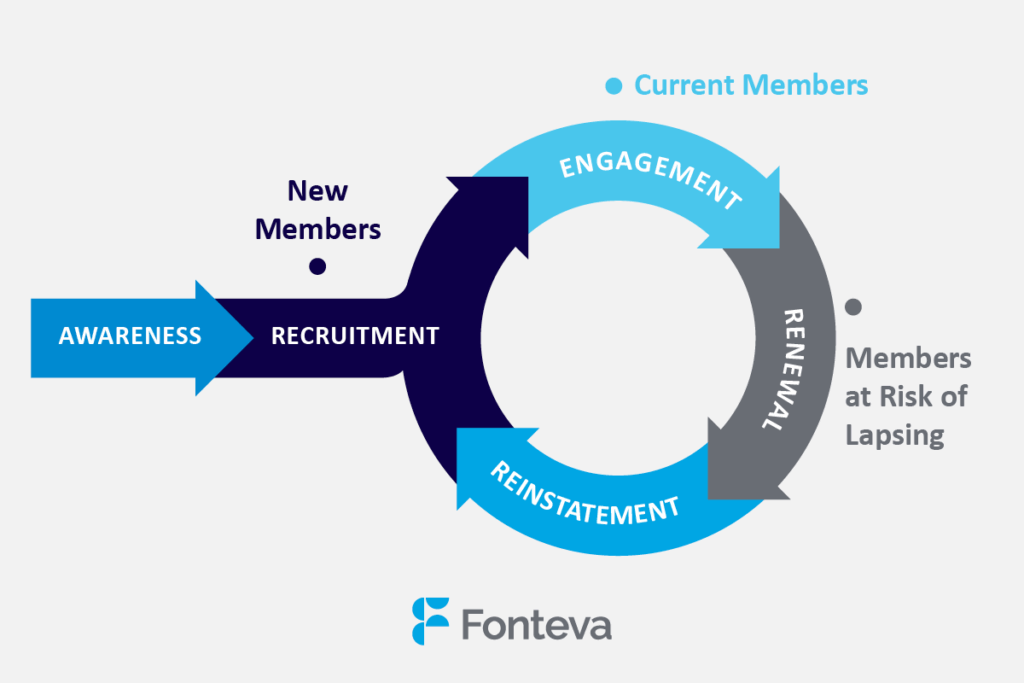
Members will respond to your engagement strategies differently depending on which phase they are in—for example, you wouldn’t invite a member of three years to a welcome happy hour. Instead, associations should target different types of members with tailored engagement opportunities.
Here are ways you can engage three different types of members:
New members
A new member is one that your association recently recruited. They are very new to the organization and likely still need help navigating your membership portal and getting to know fellow members. These members fall into the recruitment and/or early engagement stages of the membership lifecycle.
Here are some ways to engage new members:
- A welcome email series. Put together a set of emails to automatically send to any new member, triggered by the new member completing the enrollment process. These emails should have clear and engaging subject lines and include instructions for setting up any necessary accounts, an onboarding checklist, contact information for members who can help them get acquainted, and links to important association resources.
- Onboarding webinars. In addition to an email series, consider creating a webinar to walk through the basics of getting plugged in at your association. The webinar should also touch on the exclusive benefits offered by your association. Make this webinar readily available through your membership portal.
- Mentorship programs. Help members get to know their peers by pairing them with another member to mentor them. The program can last anywhere from six months to a year or more. Make sure the mentors you choose are knowledgeable about the association’s offerings.
At this stage, it’s key to make a positive impression on new members, teach them to navigate the association, and help them build relationships with peers. Additionally, share all the benefits and opportunities they can take advantage of as members, such as earning certifications.
Current members
Current members are those who have passed the initial onboarding stage. This can include those who have already renewed their membership in previous years or first-year members who fall between onboarding and renewal. In the membership lifecycle, these members are in the engagement phase.
To engage current members, leverage the following engagement strategies:
- Advanced learning opportunities. Promote any online courses, certifications, and/or interactive workshops your association has, and, if possible, create more based on members’ interests. To engage your more senior members, make sure these go above and beyond common knowledge in your industry.
- Member-generated content. Give members the chance to create and share content about their areas of expertise. For example, if a member of your restaurant association is passionate about preventing burnout and protecting the mental health of cooks and chefs, offer to have them create a blog post and host a special webinar about the issue.
- Leadership opportunities. Your most dedicated, involved members are the most likely to volunteer their time to your association by taking on leadership roles. Share about these opportunities in targeted emails and promote the importance and benefits of holding these roles.
These members often seek ways to get more from your association, so ensure your engagement strategies go beyond the surface level. Remember to collect feedback from members about your association’s offerings and implement feasible suggestions. This shows that you care about members’ opinions and want to create value that appeals to them.
Members at risk of lapsing
Members who are at risk of lapsing are those who are nearing the renewal period. During this time, they’ll decide whether to pay for another year of membership. Renewals are like a vote of confidence in your association, and they make up an important part of your revenue.
While your association may already send messages prompting members to renew, you can take it further by reminding them of the benefits of being a member.
Consider engagement strategies such as:
- Providing a customized value proposition. Using your association management software, create a segment of members approaching renewal. Then, further segment those members by interest and send customized value propositions that highlight the benefits related to their preferences. For example, highlight upcoming conference events to members who value connecting with professionals in your sector.
- Offering exclusive discounts. Offer early renewal discounts to motivate members to renew as quickly as possible. For example, set a deadline one month before their renewal date and offer 10% off the next year’s membership if they renew in time.
- Extending member appreciation benefits. Show that you value current members’ investment in your association. You might send eCards for milestones or birthdays, acknowledge members who have been with your organization for long periods of time or offer digital badges displaying how many years they have been active.
- Allowing members to opt into auto-renewal. Using your association management system, enable members to set up auto-renewal. This way, they don’t have to worry about manually renewing their membership each year. Just make sure to send out a notification letting them know their membership is about to renew.
Remember that you likely won’t retain every member, and that’s okay. For any members who cancel their membership, send a survey asking why they decided not to renew. These answers should give your association a solid starting point when making updates and improvements to its benefits and engagement tactics
Execute Your Member Engagement Strategy With Fonteva’s AMS
If your association is looking for an effective, reliable association management solution, then look no further. Fonteva has worked with hundreds of associations for over a decade. Through our powerful Salesforce-native association software, we strive to reduce the burden of association management and member engagement.
With more powerful and comprehensive tools than a simple association management system, Fonteva provides an all-in-one association management platform that gives you and your team access to:
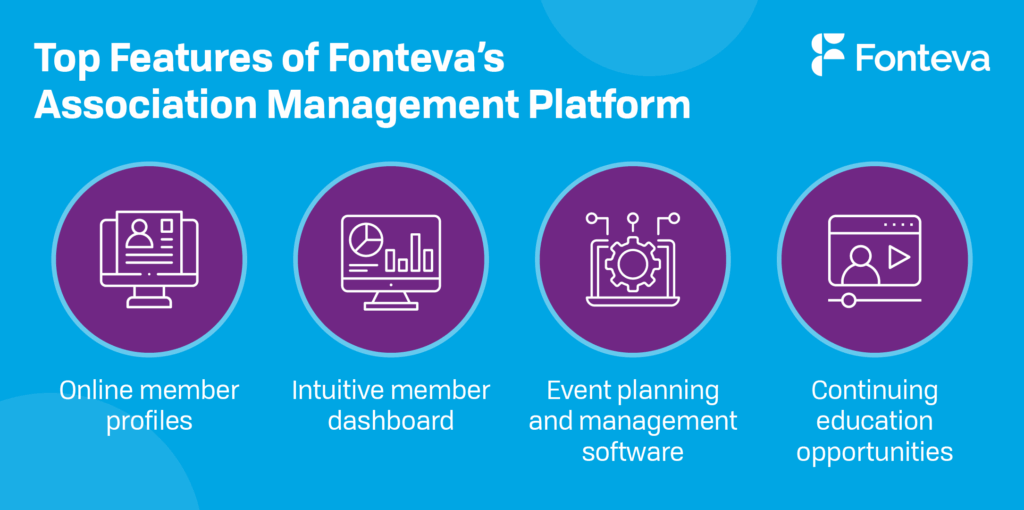
- Online member profiles. Engage your constituents online by providing a public member directory. This gives members a chance to get to know each other and even interact on an online message board. Members can also edit their own profiles and update any inaccuracies.
- An intuitive member database. An intuitive CRM system makes it easy to personalize member communication. Because Fonteva is native to Salesforce, your member profiles will be fully fleshed out and regularly updated with engagement metrics from event attendance, payment preference, and more!
- Event planning and management software. Fonteva’s association management platform includes event management tools, so there is no need to look for a third-party solution. You can easily host an event microsite, create a mobile event app, and manage all event personnel on one streamlined platform!
- Continuing education opportunities. People join associations to stay up-to-date on best practices and innovations in their field. With Fonteva, you can offer certifications, learning events, online courses, and more.
Fonteva’s comprehensive association management platform also helps your association visualize past data to improve your member engagement and retention strategies for the future. With flexible reporting tools, you can easily see which communications, events, and other forms of outreach are working and which need to be tweaked.

Wrapping Up
Actively engaging your members is an ongoing journey, but certain strategies can simplify the process. By investing in reliable association management software, you can easily compile reports to understand these goals and form measurable KPIs to take appropriate action.
Eager to learn more about strategies and tools that you can use to elevate your association and engage your members? Check out these additional resources:
- A Guide to Transforming Your Association With an AMS System. Explore the ins and outs of association management systems and check out some of the top providers in the industry.
- Salesforce for Associations: A Comprehensive Guide. Does your association depend on Salesforce? Check out our top tips and software solutions for your organization to make the most of this powerful CRM.
- How to Set Up Your Membership Directory + Key Elements. Membership directories are an effective way to help members connect and form lasting relationships. Use these essential tips to set up your membership directory.
